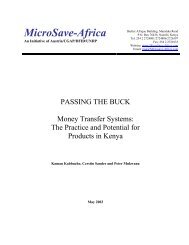You also want an ePaper? Increase the reach of your titles
YUMPU automatically turns print PDFs into web optimized ePapers that Google loves.
<strong>DAI</strong> subsidiary<br />
ECIAfrica grew<br />
quickly and was<br />
earning significant<br />
revenues by 2004.<br />
72<br />
Building a Global Network<br />
<strong>DAI</strong>’s Board had accepted the logic <strong>of</strong> market<br />
diversification in the 1999 strategic plan and<br />
kept management’s feet to the fire on this issue<br />
even as traditional business growth was<br />
dramatically exceeding plan targets. Global<br />
expansion through local companies organized<br />
in a network configuration intrigued Barclay and<br />
became his top priority. He saw great potential<br />
for decentralized local business units to win<br />
and execute business with clients beyond the<br />
reach <strong>of</strong> the Bethesda-based team, if those<br />
units could draw on <strong>DAI</strong>’s worldwide experience<br />
while tapping their firsthand knowledge <strong>of</strong> their<br />
clients’ needs. Assembling the right pieces in<br />
this global/local puzzle proved quite difficult, for<br />
a number <strong>of</strong> reasons.<br />
By 2000, the company had a presence in several<br />
countries, ranging from the Bannock (Europe)<br />
and ECIAfrica (southern Africa) subsidiaries to<br />
remnants <strong>of</strong> the Asia marketing network created<br />
in the 1990s. Improving and expanding the subsidiary<br />
companies was the preferred alternative.<br />
Barclay believed that by sourcing local consulting<br />
talent, and fielding managers on the ground<br />
to develop close relationships with new clients,<br />
the subsidiaries could <strong>of</strong>fer more cost-effective,<br />
more competitive services than those <strong>DAI</strong> typically<br />
included in its proposals to USAID. He<br />
put this commitment to globalization front and<br />
center in management discussions and, in the<br />
fall <strong>of</strong> 2002, laid out <strong>DAI</strong>’s “2010 Global Leadership<br />
Vision” in a presentation to the Board.<br />
The executive team, and some Board members,<br />
were unsure if the network model could<br />
really work. The record <strong>of</strong> <strong>DAI</strong>’s subsidiaries<br />
was mixed. MAS, a bank training subsidiary<br />
attached to <strong>DAI</strong> headquarters, had been shut<br />
down in 1999 due to a lack <strong>of</strong> business, and serious<br />
accounting problems in MAS would come<br />
back to haunt <strong>DAI</strong> several <strong>years</strong> later. Progress<br />
in London was disappointing, because Bannock<br />
Consulting had never aligned itself with the <strong>DAI</strong><br />
corporate strategy and failed to capitalize on<br />
the parent company’s experience and assets.<br />
Heavy turnover in Bannock’s management<br />
ranks began to cripple the company in 2003.<br />
ECIAfrica provided a better example in certain<br />
respects, although its success would not be<br />
sustained after <strong>DAI</strong>’s seconded management<br />
team rotated back to Bethesda. The team <strong>of</strong><br />
Adam Saffer and Bill Grant had positioned



